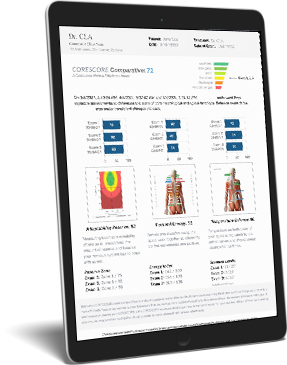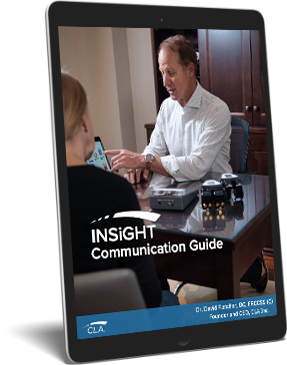Effective communication is the cornerstone of a thriving chiropractic practice. Everyexam and re-exam interaction with your patients isn’t just a routine check-up. It’s an opportunity to build trust, educate, and inspire. Mastering the art of communication can transform your relationships with patients, leading to better outcomes and a more successful practice.
Think of communication as the bridge that connects your expertise to your patients’ understanding. Let’s dive into three powerful techniques that will enhance your ability to connect and elevate your practice.
The top chiropractic communication techniques are:
- Mastering Present Time Consciousness (PTC)
- Utilizing Objective Measures to Confirm Progress
- Inspiring Confidence Through Certainty
Technique #1: Mastering Present Time Consciousness (PTC)
Present Time Consciousness (PTC) is about being fully present with your patient in the moment. This is where true connection happens. Your patients have rearranged their schedules and invested in their health to be with you. That commitment deserves your LASER FOCUS—even before you make the adjustment.
Your words hold immense power, so ensure you:
- Gather Updated Information: Ask about any changes since their last visit.
- Stay in the Present: Eliminate distractions and focus entirely on the patient.
- Guide the Message: Steer conversations toward their nervous system and overall well-being.
Reframing the Conversation
Many people view health through the lens of “Feel Better, Get Well, Stay Alive.” This mindset focuses on symptom relief rather than true wellness. In your practice, shift this perspective to:
Get Better, Stay Well, Feel Alive!
This rephrasing encourages patients to embrace a proactive approach to lifelong health. It’s about moving beyond symptoms and transforming how the body functions through a NERVE FIRST mindset. When your words reflect this philosophy, patients begin to see themselves on a journey toward optimal health, not just the absence of illness.
The Power of Intent
Instead of the usual “How are you?” at the start of a visit, try this:
- Make Eye Contact
-
- Gently Touch Their Shoulder as they settle onto the adjusting table
- Ask, “What’s different today?”
This simple question shifts the focus to positive changes and progress. Your intentional presence makes each session more meaningful and strengthens your connection with the patient.
Activity: Practice the “3-Minute Presence Drill”
Spend three minutes at the beginning of each shift grounding yourself. Close your eyes, take deep breaths, and visualize a patient who experienced life-changing results due to your care. This exercise sets your intention to be fully present with each person who walks through your door. Repeat this drill whenever you need to recenter your focus.
Technique #2: Utilizing Objective Measures to Confirm Progress
Everyone loves hearing good news. Highlighting the positive changes your patients experience using objective measures is crucial. This is where advanced scanning technologies come into play.
By incorporating tools like INSiGHT scanning technology, you can provide clear and reliable insights into your patients’ progress. The INSiGHT neuroTECH combines three neurofunctional assessments that transform any practice. It’s neuroscience at your fingertips, allowing you to examine patients of all ages, report objective findings, and enhance patient engagement.
Making Progress Visible
Using the CORESCORE, you can demonstrate how much their nervous system is improving. Instead of saying, “Your back pain is getting better,” you might say:
“Alex, your CORESCORE has increased from 65 to 72! This shows that all your efforts are truly paying off. Your nervous system is becoming more efficient at handling stress, meaning your body is functioning better on its own. Have you noticed feeling more energetic or focused lately?”
This approach not only validates their progress but also motivates them to stay committed to their care plan, knowing it’s based on solid data, not just subjective feelings.
Activity: “CORESCORE Storytelling Challenge”
Challenge yourself to explain your patient’s CORESCORE in different ways each week. Find creative narratives that link the data to their daily lives. For example, say, “Your nervous system is starting to operate like a finely tuned orchestra, with everything in harmony!” Use metaphors that resonate with your patients to deepen their understanding and engagement.
Technique #3: Inspiring Confidence Through Certainty
Here’s a mantra to embrace: Certainty. Pays. Big. When you communicate with certainty, patients are drawn in and inspired by your confidence. This is especially impactful when presenting objective data that supports their progress.
The Power of Words
Think of your communication as an extension of your data. Every scan, every CORESCORE report, and every piece of progress you share is an opportunity to inspire. When you confidently explain how their nervous system is healing and reorganizing, it transforms their perception of chiropractic care. They evolve from skeptics to advocates for their own health.
Here’s an empowering way to discuss progress with a patient:
“Your nervous system is lighting up in the best way possible! It’s becoming more efficient, adapting seamlessly, and making you more resilient to life’s challenges. Our goal is to keep strengthening these connections so you can stay well and truly feel alive!”
This message reinforces that they are on a path not just to feel better but to thrive in ways they hadn’t imagined.
Activity: “Certainty Role-Play Exercise”
Pair up with a colleague or practice in front of a mirror. Role-play explaining a patient’s progress with absolute certainty using their CORESCORE data. Focus on eye contact, a confident tone, and positive body language. Record yourself if possible and review to identify areas for improvement.
Integrating INSiGHT Scanning and CLA Tools into Communication
Incorporating INSiGHT scanning technology and tools like the INSiGHT neuroTECH can revolutionize your communication and enhance patient relationships.
Introducing INSiGHT neuroTECH
The INSiGHT neuroTECH combines three scanning technologies to create a comprehensive neural profile, shifting the conversation from ‘pain to performance’:
- neuroPULSE (HRV): Measures heart rate variability to assess adaptability.
- neuroCORE (sEMG): Scans neuromuscular activity related to posture and spinal movements.
- neuroTHERMAL (Thermal): Explores deeper nerve connections affecting organs and glands.
These tools enable you to:
- Examine Patients of All Ages: From infants to seniors.
- Report Objective Findings: Provide tangible evidence of progress.
- Increase Patient Engagement: Patients remain engaged when they see real, measurable results.
Leveraging Synapse Software
The Synapse software powers INSiGHT technologies, offering features that enhance patient communication:
- CORESCORE Reports: Track progress over time with adult and children’s reports.
- neuroLINK: An interactive tool connecting scan results with neural pathways, showing how spinal health impacts overall well-being.
- Customizable Scan Views: Personalize reports to reflect your practice’s unique style.
By integrating these advanced tools, you make each interaction more impactful, helping patients understand their health on a deeper level.
Examples of Integration in Practice
Imagine showing a patient their scan results on an iPad during their visit. As you discuss the findings, you use the neuroLINK feature to illustrate how specific spinal areas relate to their symptoms and overall health. This visual aid reinforces your explanations and keeps the patient engaged.
Elevate Your Practice with Effective Communication
Shifting your words and integrating advanced technology into your practice can significantly enhance patient relationships. Reflect on your current communication techniques:
- Are your conversations empowering and informative?
- Do you utilize tools that make the invisible visible for your patients?
- How can you enhance your communication to build trust and loyalty?
By focusing on these techniques, you not only improve patient outcomes but also foster a thriving practice built on strong, lasting relationships.
Let your words and innovative tools be the catalysts that help patients transition from merely feeling better to truly living well. Create lifelong change for your patients through effective communication.
Take the Next Step to Enhance Your Practice
Are you ready to elevate your chiropractic practice? Discover how tools like INSiGHT scanning technology can help you improve communication and patient engagement.
Book a call with an INSiGHT Advisor today to learn how you can take your patient interactions and your practice to the next level.
























































































